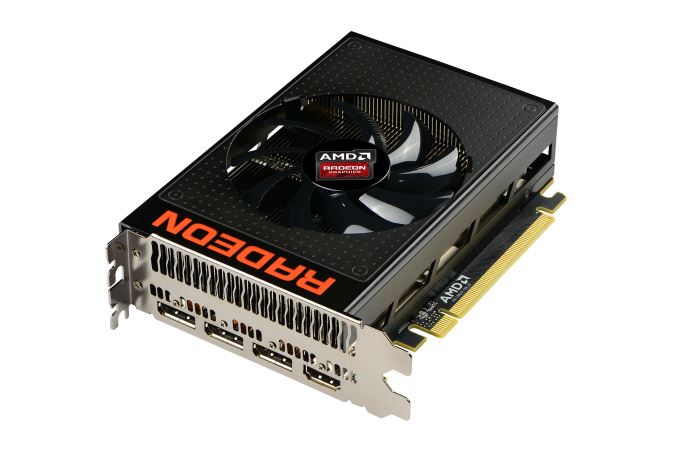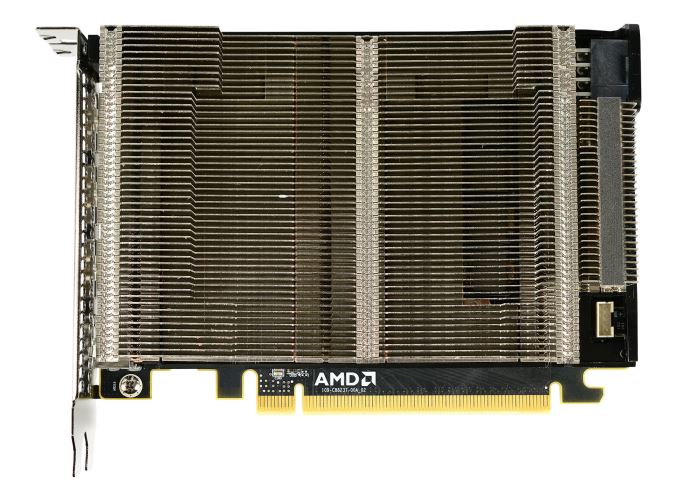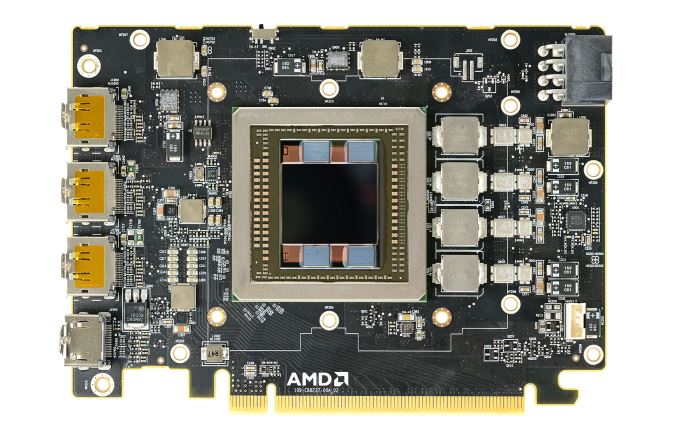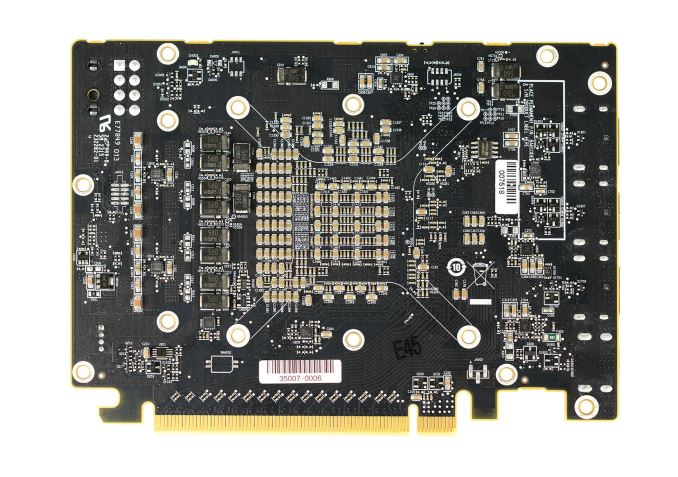The AMD Radeon R9 Nano Review: The Power of Size
by Ryan Smith on September 10, 2015 8:00 AM ESTMeet The Radeon R9 Nano
6 inch video cards are by no means a new thing in the GPU space, however these are traditionally lower-end products that need neither a large cooler nor an extensive power delivery system. As a result the R9 Nano is something of an interesting aberration, packing a lot more power and a lot more technology into half a foot of video card than what we normally see.
Starting as always from the top, the R9 Nano measures 6” long, which is actually a bit shorter than the full length the Mini-ITX standard allows. Responsibility for cooling the card falls to the R9 Nano’s new open air cooler, an aggressive design that has been specifically tailored to allow the card to effectively dissipate 175W of heat in such a small space.
The overall design of the R9 Nano’s cooler is best described as a combination open-air and half-blower hybrid. The design is technically open-air, employing a single axial fan to cool the card. However with only a single fan AMD has been able to align the heatsink fins horizontally and then place the fan in the center of the heatsink. The end result is that roughly half of the heat produced by the card is vented outside of the case, similar to a full blower, while the other half of the heat is vented back into the case. This reduces (though doesn’t eliminate) the amount of hot air being recycled by the card.
The heatsink itself is composed of aluminum and runs virtually the entire length of the card. This is technical a two-piece heatsink, with the primary heatsink composing the bulk of the card, while a much smaller secondary heatsink it found towards the far end of the card and mounted on top of a heatpipe.
Drilling down, we find that the primary heatsink is fed by a combination vapor chamber and heatpipe design. A copper vapor chamber serves to draw heat away from the Fiji GPU and HBM stacks, and then heatpipes are used to better distribute heat to the rest of the heatsink. The use of a vapor chamber in the R9 Nano makes a lot of sense given the fact that vapor chambers are traditionally the most efficient heatsink base type, however the R9 Nano is also unique in that we typically don’t see vapor chambers and heatpipes used together. Other designs such as the high-end GeForce series use a single large vapor chamber across the entire heatsink base, so among reference cards at least the R9 Nano stands alone in this respect. In this case given AMD’s design goals for size and noise, a vapor chamber will play a big part in helping the small card effectively and quietly dissipate 175W.
As for the physical PCB itself, as we can see AMD made it a relatively packed card in order to get the R9 Nano down to 6 inches. Compared to the R9 Fury X reference board, the biggest change here is that AMD has removed a fair bit of power circuitry to save space. By our count there are 4 VRM phases to feed the Fiji GPU, as opposed to the 6 found on R9 Fury X. Power delivery is handled by a single 8-pin PCIe power socket, which is becoming increasingly common, replacing the 2x 6-pin setup for 150W-225W cards.
Meanwhile to further shrink the overall PCB footprint, AMD has moved some of the remaining power delivery circuitry to the back of the card. The front of the card still contains the inductors and heat-sensitive MOSFETs, while a number of capacitors are on the rear of the card (and is why you won’t find a backplate).
Finally, for display I/O R9 Nano is unchanged from R9 Fury X. This means we’re looking at a DVI-free design, with 3x DisplayPort 1.2 and 1x HDMI 1.4 port all along a single row of the I/O bracket. Buyers looking to put together HTPCs will want to be especially mindful of the HDMI 1.4 port; while it's not necessarily a deal-breaker, it does mean that the R9 Nano can't fully drive 4Kp60 TVs, which are slowly but surely becoming more common.
Overall AMD is rather confident in their design for the R9 Nano. The heatsink is built to efficiently dissipate more heat than the 175W the card requires (despite the small size), and as a result we never see the R9 Nano thermally throttle under normal operation. The card’s thermal throttle point is 85C, and in our testing the card never passed 75C, exactly as AMD promised us. What ends up limiting the R9 Nano’s performance then is exactly as expected: the power throttling.
















284 Comments
View All Comments
gw74 - Thursday, September 10, 2015 - link
there is no evidence or reason to believe the 3.5GB was anything but an honest mistake, and it was all handled admirably by Nvidia once discovered.You are not the arbiter of what is and is not dead to me, and your condescending attempt to explain its consequences to me is not required.
The point about AMD is that their actions reveal untrustworthiness. Buying a product from someone untrustworthy can have all sorts of negative consequences, whatever the apparent quality or value at the time of purchase.
Pipe down. Have a seat. Have a Diet Coke.
RussianSensation - Thursday, September 10, 2015 - link
"there is no evidence or reason to believe the 3.5GB was anything but an honest mistake, and it was all handled admirably by Nvidia once discovered."Yes, the engineers accidentally designed the card with 3.5GB of VRAM and gimped ROPs. Sure, it was just an accident. Not only that, after it was found out, NV didn't change the specifications for ROPs and VRAM on the boxes of newly produced GTX970 cards. GTX970 doesn't have full speed GDDR5 memory and doesn't have the full stack of ROP performance of GTX980 card. Therefore, it's not a true 4GB GDDR5 card because the last 0.5GB operate at only 28GB/sec which is basically useless.
"and it was all handled admirably by Nvidia once discovered."
NV did absolutely nothing. They showed 0 remorse. It was AIBs that accepted returns. NV didn't provide a return program for existing customers, didn't offer discount coupons for future NV GPUs, they didn't offer a game coupon, they literally did nothing. In fact, they tried to cover it under the rug with PR mouthpieces from sites like PCPerspective how 3.5GB of VRAM doesn't matter.
"The point about AMD is that their actions reveal untrustworthiness. Buying a product from someone untrustworthy can have all sorts of negative consequences, whatever the apparent quality or value at the time of purchase."
What so untrustworthy about AMD's Nano or AMD's graphics cards? The Nano beats GTX970 mini by at least 30%, just like AMD stated. AMD never aimed or claimed to have the Nano being a price/performance king.
gw74 - Thursday, September 10, 2015 - link
This has nothing to do with engineering, the mistakes were in marketing. Nvidia self-evidently showed remorse by admitting and correcting the mistakes and facilitating refunds with retailers. Nvidia don't produce reference 970s, the drop-in card manufacturers do, so which boxes do you mean?For what is untrustworthy try reading my comments.
Oxford Guy - Thursday, September 10, 2015 - link
You should read his rebuttal since clearly you didn't.gw74 - Friday, September 11, 2015 - link
who should read who's rebuttal?RussianSensation - Thursday, September 10, 2015 - link
@gm74,Even if you state that marketing is 100% at fault, which is hard to believe, NV is still responsible for how the product is marketed after the facts came out. It was AIBs that agreed to accept the cards back, not Nvidia. It would be akin to AT&T or Verizon accepting returns of flawed Blackberry phones but Blackberry not offering any refunds directly. NV never offered direct refunds, never issues any game vouchers or discounts as remorse. Stating online that the are sorry does nothing. It's empty PR.
The way professional companies deal with mistakes is completely different than how NV handles it. After the disastrous Bumpgate scandal, the way they treated GTX970 fiasco is shockingly poor.
Mazda after they made a mistake:
"Mazda is offering to buy back most of the 3,551 RX-8 rotary-engine sports cars sold since the July launch because engine power is as much as 5% less than advertised — an important difference to sports car enthusiasts.
Those who tell Mazda they will keep their cars get free scheduled maintenance for the four-year, 50,000-mile warranty period, plus $500."
http://usatoday30.usatoday.com/money/autos/2003-09...
What did Nvidia do in particular for GTX970 owners? Nothing, 0, zilch, nada.
You state that NV isn't responsible for what goes on the marketing boxes of its AIBs? Are you serious. So after NV was caught lying about specifications, did it tell its AIBs to change the specs on their newly printed boxes? If not, they are still lying to consumers and they are OK with AIBs misrepresenting the data.
Kutark - Thursday, September 10, 2015 - link
Im not going to get into the whole debate, but since we're clearly being pedantic here. It was a 4gb card. It absolutely has 4gb of vram. They never advertised it as "4gb (but with .5gb of slower ram!)", so if you want to get on them for that, go for it. But claiming its a 3.5 gb card when it *is* a 4gb card is just as ridiculous as any of the other assertions you're getting on him for making.Oxford Guy - Friday, September 11, 2015 - link
You're not being pedantic. You're being wrong. A lie of omission is a form of lie. 28 GB/s VRAM performance, half that of a midrange card from 2007, is NOT a reasonable expectation for an enthusiast-level card or even any card with DDR5.gw74 - Friday, September 11, 2015 - link
it's not a lie of omission.anubis44 - Thursday, October 8, 2015 - link
Of course it's a misrepresentation. Nobody who reads '4GB' will assume that the last .5GB is so slow that it's essentially necessary to limit game textures to 3.5GB or the game will be suddenly stuttering and the card will be brought to its knees. Give me a break. That's like me marketing a gold bar as 1KG of 'pure gold', but in fact, it's only 750grams of 24K gold, and 250 grams of 10K gold. It's willfully and deliberately deceptive, and if you don't say so, you're complicit in their scam.